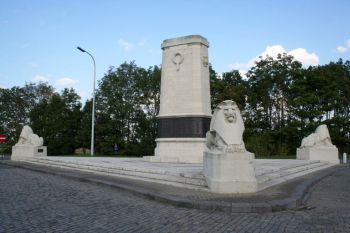|
|
| Home Topics Memorials Miscellany Transcripts References Family History Glossary Latest Beeston Blog About us | Site Search |
|
Andrew Victor Guy was born in Long Eaton, Derbyshire in 18962, the eldest of five surviving children of Andrew Victor (b. 1873, Surrey) and Gertrude Catherine E M Brown (b. 1876, Beeston, née Brown). Andrew senior worked as a bricklayer and, by 1901, was living at Hilltops, Bolsover with his wife and five-year-old Andrew junior3. In about 1908, the family moved to Beeston and, by 1911, were living at 1 William Street - a small street off the south side of Middle Street which no longer exists - and, by then, Andrew junior was working as a journeyman printer4. As Andrew's Army Service Record has not survived, we do not have a precise record of when he enlisted, but it was probably towards the end of 1916 with the 16th Battalion, Northumberland Fusiliers5. This battalion, one of the Pals Battalions, had been formed in Newcastle as part of Kitchener's Second New Army in September 1914 and had arrived in France in November 1915 as part of 96th Brigade in the 32nd Division. By the time Andrew had completed his training and been posted to France, the battalion had seen action during the Battles of the Somme in 1916. Then, in early 1917, it was part of the Operations on the Ancre and the subsequent Pursuit of the German retreat to the Hindenburg Line. During this time, and subsequently, the battalion would have received several drafts of reinforcements of newly trained men6. Although we do not know exactly when, Private Guy would have been part of one such draft. What is clear is, that he was a member of the battalion when it was assigned to coastal defences in the Bray Dunes Sector on the France/Belgium border, which includes a number of aerodromes which were vital to the operations of the Royal Flying Corps. British units had returned to this sector of the Western Front in June 1917, when the 32nd Division relieved French troops stationed at Nieuport in preparation for planned Allied landings on German-held territory along the Belgian coast. However, German marines launched a pre-emptive attack against the British forces on the river Yser in July and the landings, code named ‘Operation Hush’, never took place. On August 4th the battalion was in trenches at St Georges under heavy shelling. On the 6th they successfully raided enemy positions but, on the following day, its support trenches were heavily shelled with heavy casualties. A further attack on the 8th successfully reached its objectives but not without heavy casualties - a total of 1 officer and 27 other ranks killed, wounded or missing. Private Guy was amongst those missing and was eventually declared presumed dead7. As Private Guy's body was never identified he is commemorated on the Nieuport Memorial. Nieuport (now Nieuwpoort) is a town in the Province of West Flanders on the south-west side of the River Yser, three kilometres from the sea. The Nieuport Memorial is on a site where the road to Lombardsijde joins the road from Nieuport dock. The memorial commemorates 566 Commonwealth officers and men who were killed in Allied operations on the Belgian coast during the First World War and have no known grave. Twenty of those commemorated served with the Royal Naval Division and were killed or mortally wounded during the siege of Antwerp in October 1914. Almost all of the remainder fell in heavy fighting in the region of Nieuport in the summer of 19178. Private Guy was posthumously awarded the British War Medal and the Victory Medal9. His financial effects, amounting to £2 5s 10d were paid to his father on 20 August 1918 and he was also paid his War Gratuity of £3 on 25 November 191910. Footnotes 1The photograph of the Nieuport Memorial is from the Commonwealth War Graves Commission website. (http://www.cwgc.org) 2His birth was registered in Shardlow Registration District (of which Long Eaton was part) in Q1/1896 (Ref 7b 177). 3Bolsover, Derbyshire, 1901 Census, Piece 3254 Folio 55 4Beeston, 1911 Census, Piece 20432 RD429 SD7 ED6 Schedule 30. Andrew's then living siblings were Frank Reginald (b. c1902), Jane Sylvia (b. c1906), Henrietta Isabel (b.. c1909) and Charles Edward (b. 1910). Five other siblings are known to have not survived infancy. 5The probable date of Andrew's enlistment has been calculated from the amount of his War Gratuity. His medal card records an earlier service number of TR/5/1402 which may indicate that he first joined another battalion for a short period. 6Details of the battalion's formation and training are from http://www.wartimememoriesproject.com/greatwar/allied/battalion.php?pid=6789. 7This account of the battalion's involvement in the Bray Dunes Sector is derived from its war diary. 8The description of the Nieuport Memorial is from the Commonwealth War Graves Commission website. (http://www.cwgc.org) 9Details from Henry's Medal Card and Medal Roll - available on ancestry.com. 10Details from "Army Register of Soldiers' Effects, 1901-1929" - available on ancestry.com. |
|
|||||||||||
|
|
|||||||||||||
